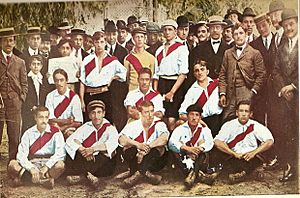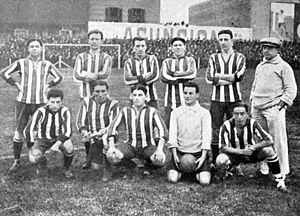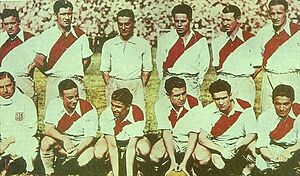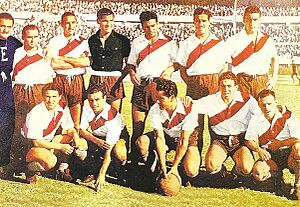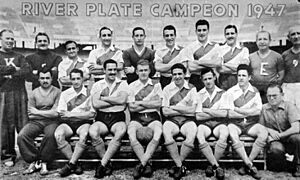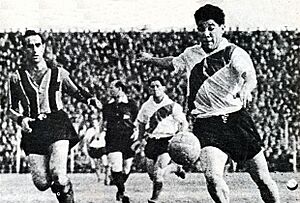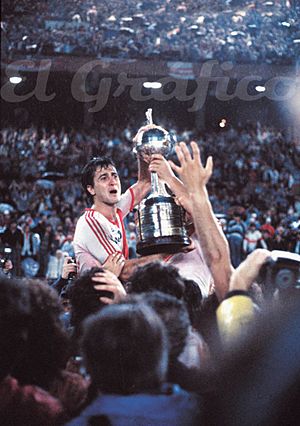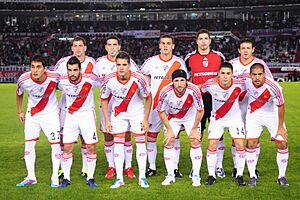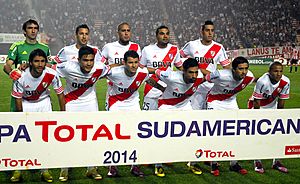History of Club Atlético River Plate facts for kids
Club Atlético River Plate is a famous Argentine sports club located in the Nuñez area of Buenos Aires. Their football team is one of Argentina's most successful. They have won the top professional league, the Argentine Primera División, a record 38 times! They have also won 15 national cups.
River Plate has also won 18 international titles. Twelve of these are recognized by important football organizations like FIFA and CONMEBOL. These include the Copa Libertadores, Copa Intercontinental, and Copa Sudamericana. They also won older international cups like the Copa Aldao and Tie Cup.
Contents
- How River Plate Started
- Winning Their First Titles
- 1931–39: "The Millionaires"
- 1940s: "The Machine"
- 1950s: First Treble
- The 1960s: A Decade Without Titles
- 1970s: Back to Being Great
- 1980s: First Copa Libertadores Win
- 1990s: Success Continues
- 2000s: Ups and Downs
- 2011 Relegation: Starting Over
- Success After the Tough Years
- See also
How River Plate Started
River Plate was founded on May 25, 1901. It was near the La Boca neighborhood, which later became home to their big rivals, Boca Juniors. The club was formed when two smaller clubs, "Santa Rosa" and "La Rosales," joined together. Leopoldo Bard was chosen as the first president.
The club got its name from something one of the members saw. Workers building the Buenos Aires Port took a break to play football. The boxes they were working with said "The River Plate." This was the name the English gave to the Río de la Plata river. This "mysterious" name was chosen for the new club.
River Plate's first football field was near the Port of Buenos Aires. Members and local managers helped build it, adding goals and fences. River then joined the Argentine Football Association. In 1905, the team played its first game in the third division, losing 3–2 to Facultad de Medicina.
The club had to move fields a few times in its early years. In 1906, they had to leave their first field. They moved to Sarandí in Greater Buenos Aires for a year. But in 1907, they returned to their first field. Later, a grandstand was built there for the growing number of fans.
Winning Their First Titles
In 1906, River Plate played in the second division. They did much better in 1907, finishing first in their section. However, they lost the final match for promotion to Nacional.
In 1908, River returned to their Dársena Sur field. They played all their home games there. The top four teams played for a chance to move up to the Primera División. River Plate beat Ferro Carril Oeste 5–1 in the semifinals. Racing Club beat Boca Juniors 2–1.
The final was on December 13, 1908, at GEBA Stadium. River beat Racing 2–1 after extra time. But the game was canceled because River fans ran onto the field to celebrate. A new match was played on December 27. River Plate won again, this time with a huge 7–0 score! This win meant they moved up to the Primera División.
River played their first game in the top division on May 2, 1909. They played against Argentino de Quilmes. In their first year, River finished second to Alumni. Alumni and Racing Club were the strongest teams in Argentine football back then.
In 1914, River won its first national championship, the Copa de Competencia Jockey Club. They beat Newell's Old Boys 4–0 in the final and didn't lose any games. River also won its first international title, the Tie Cup, against Uruguayan team Bristol F.C.
River won its first Primera División league title in 1920. This was after Racing Club had won seven championships in a row.
In 1923, River moved to a new stadium in the Recoleta area of Buenos Aires. They played their home games there until 1938.
1931–39: "The Millionaires"
In 1931, football became professional in Argentina. River Plate spent a lot of money to buy new players. They bought Carlos Peucelle for $10,000 and Bernabé Ferreyra for $35,000 in 1932. These were huge amounts of money back then! Because of this, River was nicknamed "Los Millonarios" ("The Millionaires"). This nickname has stayed with them ever since.
Ferreyra was the top scorer with 43 goals. River and Independiente both finished first. They had to play an extra match to decide the champion. River beat Independiente 3–0, winning their second league title.
In 1932, River also won the Copa de Competencia, a national cup. They beat Estudiantes de La Plata 3–1. This was also the year the team brought back their famous red sash uniform. The club's president, Antonio Vespucio Liberti, insisted on it.
River won two championships in 1936. They won the "Copa Campeonato" (the regular season) and the "Copa de Oro." They beat San Lorenzo in the final game. That same year, River Plate won its first Copa Aldao. This cup was played between the champions of Argentina and Uruguay. River beat Peñarol 5–1 in Montevideo.
The next year, River won the league title again. They scored 106 goals and only let in 43. José Manuel Moreno was the top scorer with 37 goals. Other great players were Adolfo Pedernera and Ángel Labruna. The team also won the Copa Aldao again, beating Peñarol 5–2. They also won the Copa Ibarguren in 1937, beating Rosario Central 5–0.
On May 25, 1938, the Estadio Monumental was officially opened. River played a match against Peñarol, winning 3–1.
1940s: "The Machine"
The 1940s are seen as one of the best times in River Plate's history. They won league titles in 1941 and 1942. They also won national cups like the Copa Ibarguren (1941–42) and Copa Adrián C. Escobar (1941). Internationally, they won the Copa Aldao in 1941, 1945, and 1947.
1941 was a very successful year. River Plate won four titles! They won the local championship, their third Copa Aldao, the Copa Ibarguren, and the Copa Adrián C. Escobar. Four years later, River won two more titles: the 1945 league championship and another Copa Aldao.
River had a very strong attack nicknamed "La Máquina" ("The Machine"). The forwards were Juan Carlos Muñoz, José Manuel Moreno, Adolfo Pedernera, Ángel Labruna, and Félix Loustau. This attacking line became legendary, even though they only played 18 matches together. In 1945, River won another title, with Labruna as the top scorer.
In 1947, River won a new league championship. They scored 90 goals and only let in 30. New talented players like goalkeeper Amadeo Carrizo and forward Alfredo Di Stéfano emerged from the youth teams. Di Stéfano was River's top scorer with 27 goals. The team also won its fifth Copa Aldao.
After a players' strike in 1948, many footballers went to Colombia. "Pipo" Rossi and Di Stéfano were among them. River finished second in the 1948 and 1949 tournaments.
1950s: First Treble
River went on a European tour in 1951. The next year, 1952, the team became champion. This team was also nicknamed "La Máquina" ("The Machine"). Key players included Labruna, Uruguayan Walter Gómez, Santiago Vernazza, and goalkeeper Carrizo. In 1953, River won another title.
With the return of "Pipo" Rossi and the rise of Enrique Omar Sívori from the youth teams, River won the 1955, 1956, and 1957 titles in a row. This was the first time in the club's history they won three consecutive titles. River Plate also won its sixth Copa Aldao in 1955. This was a record for the tournament, and it was the last time this cup was held.
After a big international tournament in 1957, Sívori was bought by Juventus FC for $10 million. This large amount of money was used by the club to finish building the grandstands at the Estadio Monumental.
After 1957, River went a long time without winning any titles. On October 12, 1959, Angel Labruna retired from football at age 41. Labruna is still one of the top scorers in Argentine football history. He is also one of the greatest idols in River Plate's history.
The 1960s: A Decade Without Titles
River could not win any championships during the 1960s. However, the team still had many talented players like Ermindo Onega and Oscar Más. This period is seen as the club's toughest time. It lasted until 1975, meaning 18 years without a title.
River often finished in second place during these years. In 1962, they lost the title to their big rivals, Boca Juniors. Another chance was lost in 1968 when Vélez Sársfield won the championship. In 1969, River lost the final against Chacarita Juniors 4–1.
In 1966, River played in the Copa Libertadores final against Uruguayan team Peñarol. River was leading 2–0 at halftime, but Peñarol scored two goals in the second half. The game went to extra time, and Peñarol scored two more goals to win 4–2. This loss led to rivals calling River's players and fans "Gallinas" ("Chicken"), a nickname that has stuck.
1970s: Back to Being Great
In 1975, Angel Labruna became the team's coach. Under his leadership, River won a championship after 18 years without a title! In fact, River won two titles that year: the 1975 Metropolitano and Nacional tournaments. Some key players were goalkeeper Ubaldo Fillol, defender Daniel Passarella, midfielders Juan José López and Norberto Alonso, and striker Oscar Más.
In 1976, River reached the Copa Libertadores finals. They played against Brazilian team Cruzeiro. After two matches, each team had won one game. A third game was played in Santiago, Chile, where Cruzeiro beat River 3–2.
River Plate also won the 1977 Metropolitano championship. They had many of the same players, plus striker Leopoldo Luque and left wing Oscar Ortiz. For the 1978 World Cup in Argentina, River sent five players to the national team that won the championship: Fillol, Luque, Passarella, Ortiz, and Alonso.
In 1979, River won another three titles. They won the 1979 Metropolitano and Nacional and the 1980 Metropolitano tournaments. Important players during these seasons included Fillol, Alberto Tarantini, and Luque.
Angel Labruna was not only River's all-time top scorer but also won 6 titles as the team's coach.
1980s: First Copa Libertadores Win
In 1981, Alfredo Di Stéfano became the coach. Boca Juniors signed Diego Maradona, which was a huge event in Argentine football. To compete, River signed national team top scorer Mario Kempes. They also added other players like Julio Olarticoechea and Américo Gallego. With these players, River won the 1981 Torneo Nacional championship. They beat Ferro Carril Oeste 1–0 in both final matches.
In 1982, some of River's key players left. Alonso went to Vélez Sarsfield, and Kempes returned to Valencia. Ramón Díaz and Daniel Passarella were sold to Italian clubs. In 1983, Fillol also left the club.
River then signed Uruguayan midfielder Enzo Francescoli to replace Alonso. 1983 was one of the worst years in the club's history, as they finished very low in the league. However, new league rules saved River from being moved down to the second division.
In 1984, Héctor Veira became coach. River finished second in the 1984 Torneo Nacional. In 1985, a new league format started, similar to European leagues. River won the first tournament under this new format, the 1985–86 title. They were declared champions six games before the end of the season. Enzo Francescoli was the top scorer.
In 1986, River won its first Copa Libertadores. They beat América de Cali in the finals. River then won its second international title, the Intercontinental Cup. They beat Steaua București 1–0 in Tokyo. The team finished this successful period by winning the 1986 Copa Interamericana in 1987.
1990s: Success Continues
In 1990, Daniel Passarella became coach. River won the 1989–90 tournament. They also reached the Copa Libertadores semifinals. In 1991, Ramón Díaz returned to the club. River won the 1991 Apertura with Díaz as top scorer.
Ramón Díaz left again in 1993. However, River won the 1993 Apertura with young talents like Ariel Ortega, Marcelo Gallardo, and Hernán Crespo.
In 1994, Enzo Francescoli returned to the club. River won another title that year, the 1994 Apertura. They were coached by former player Américo Gallego. River also went unbeaten that season, a first in the club's history.
Ramón Díaz returned as coach in 1995. The next year, River won its second Copa Libertadores. They beat América de Cali in the finals again, ten years later. Hernán Crespo scored the two goals in the deciding match.
River then won three more titles in a row: the 1996 Apertura and 1997 Clausura and the 1997 Apertura. Internationally, River won the 1997 Supercopa Sudamericana. They beat São Paulo in the finals, with great performances from Marcelo Salas and Marcelo Gallardo. After these wins, Enzo Francescoli retired. The 1996/1997 River Plate team is considered one of the best teams in South American football history.
In 1999, River won its last title under Ramón Díaz, the Apertura tournament. Javier Saviola was the top scorer with 15 goals. Saviola was also the youngest player to play for River Plate, at age 16. Pablo Aimar was another key player.
That same year, a sports magazine named River Plate "Champions of the Century." This was because of their many achievements, especially their 30 league titles at the time.
2000s: Ups and Downs
On May 25, 2001, River Plate celebrated 100 years since its founding. They had a big march and a friendly match against Peñarol. This year, River did not win a title. They were knocked out of the Copa Libertadores. Key players like Pablo Aimar and Javier Saviola were transferred to European clubs.
In 2002, Ramón Díaz returned as coach. River brought back Ariel Ortega and promoted young players like Andrés D'Alessandro and Fernando Cavenaghi. They won the Clausura tournament, which was Ramón Díaz's seventh title as coach. This included a 3-0 victory against Boca Juniors. Ramón Díaz left at the end of that year.
In 2003, River won the Clausura tournament again. They were led by Chilean coach Manuel Pellegrini. The team included players like Leonardo Astrada, D'Alessandro, Cavenaghi, Javier Mascherano, and Martín Demichelis.
In 2004, with Leonardo Astrada as manager, River won the Clausura tournament. This was their thirty-second national championship. The team also reached the semifinals of the Copa Libertadores against Boca Juniors. Boca won the first game, and River won the second. But River lost in a penalty shootout. After this, many of River's star players left the club.
In 2008, Diego Simeone became manager. In his first season, he led them to their first league title in four years, winning the Clausura championship. However, the next season, the club played very poorly. Simeone resigned, and River finished last in the Apertura 2008. This was the first time River had ever finished last in a league in 107 years.
2011 Relegation: Starting Over
In 2011, River Plate faced big problems both as a club and on the field. The team finished very low in the league. As a result, River had to play a special two-game play-off called the Promoción. They played against Belgrano de Córdoba, a team from the second division. Belgrano won the first game 2–0. In the second game, River drew 1–1. This meant River Plate was moved down to the Nacional B (second division) for the first time in its history. The second match was stopped because of problems in the stadium.
Back to the Top Division
Matías Almeyda retired as a player to become the team's coach. Fernando Cavenaghi and Alejandro Domínguez returned to the club to play in the second division. In January 2012, David Trezeguet and Leonardo Ponzio also joined the team. In June 2012, River won the second division title. They beat Almirante Brown 2–0 in the last game. This meant they returned to the Primera División for the 2012–13 season.
A week later, River's youth team won the U-20 Copa Libertadores in Peru.
After some disagreements with the club president, coach Matías Almeyda was fired in November 2012. The next day, it was announced that Ramón Díaz would become River's coach for the third time.
Success After the Tough Years
On May 18, 2014, River won their 36th national league title. They won the 2014 Torneo Final by beating Quilmes 5–0. A week later, River won the 2013–14 Superfinal against San Lorenzo. Ramón Díaz then resigned as coach. A few days later, Marcelo Gallardo was named the new coach for River.
On December 10, River won its first CONMEBOL tournament in 17 years: the 2014 Copa Sudamericana. River Plate beat Colombian team Atlético Nacional in the finals, winning 3–1 over two games. On the way to the final, River Plate had beaten their big rivals, Boca Juniors.
As champions of the 2014 Copa Sudamericana, River played against San Lorenzo (who won the 2014 Copa Libertadores) in the 2015 Recopa Sudamericana. River won both games 1–0 to win their first Recopa Sudamericana. River also started their 2015 Copa Libertadores campaign. They had a tough start but managed to qualify for the knockout stage.
River then played Boca Juniors in the round of 16. River won the first game 1–0. In the second game, River players were attacked with pepper spray. The match was stopped, and Boca was removed from the tournament. River went on to reach the finals for the first time since 1996. River Plate won the final and the 2015 Copa Libertadores by defeating Tigres UANL 3–0.
On November 11, 2018, River drew 2–2 with Boca Juniors in the first game of the 2018 Copa Libertadores final. They then won the second game 3–1 at the Santiago Bernabéu Stadium in Spain. This win gave them the Copa Libertadores for the fourth time.
See also
 In Spanish: Anexo:Historia del Club Atlético River Plate para niños
In Spanish: Anexo:Historia del Club Atlético River Plate para niños



